Public education is a pillar of Russian society. All children within Russian borders — regardless of race, religion, gender, or citizenship — are given the opportunity to learn. In 2009, President V.Putin signed into law the USE act (unified state exam) to guarantee that everybody should have equal rights for getting higher education. However, the results from Pisa’s [1] survey in Russia showed that the quality of training of school leavers left much to be desired. Leaders of schools and educational authorities were looking for methods to improve student achievements. Many experts believed that student discipline had a significant influence on that process (a school uniform is one of the factors that can influence student discipline). For this reason in 2014 the senators of our parliament approved the amendments to the Federal law “On education” in the part of requirements to clothes of students.
Now school uniforms are used all across the country. Despite their widespread use and even though politicians and administrators specifically cite improvements in discipline and achievement as justifications for uniform adoption, the effects of uniforms on students remains unclear .
Proponents of uniforms suggest that the largest impacts may be on non-cognitive skills such as self esteem and discipline. Recently researchers have established that non-cognitive skill formation is an important part of education and may be just as important a determinant of students' future social and employment success as academic ability. Administrators often believe uniforms create a safer learning environment while students have said they notice little difference in the school. Some school administrators believe that uniforms can improve discipline and raise academic achievement. Others believe there is a positive correlation between uniforms and test scores. Additionally, some believe that school uniforms provide an equitable learning environment for students. In other words, teachers may treat students differently if one looks better or has better clothes than other students, but a school uniform policy helps give everyone a fair chance of education without the bias of family income.
On the other hand, there are the factors that having an influence on performance and behavior are often unable to be controlled by schools. For example, parental involvement has a strong correlation to achievement. The more parents are involved in their children’s studies and activities, the more likely the child will be successful academically. Parental involvement can also reduce the chances of a child becoming involved with gangs, abusing alcohol, and engaging in other negative behaviors that would also influence academic performance.
Other detractors say that uniforms are an unnecessary burden and infringe on students’ rights. In addition, some minority groups see school uniforms as a restriction on students’ cultural expression of dress rights.
Statement of the problem
A school uniform policy is a fundamental change in the educational environment. The educational authorities receive complaints from parents regarding lack of choice and high prices / poor quality of school uniforms. Some people do not understand why it is necessary to wear a school uniform. Students must relinquish some freedom in exchange for a supposed improvement in the educational environment. For this exchange to be worthwhile, actual benefits to academic achievement and student behavior should be observed. Therefore, the objectof our study is a school uniform and the subjectof our study is the pros and cons of wearing a school uniform .
Rationale
The goalof our study is to find out the benefits and implications of instituting a school uniform policy at our school. A large number of people including our teachers, students, parents want to know why some students wear a school uniform regularly but others never do that. Furthermore, school officials need to be aware of the positive and negative effects of school uniforms.
To achieve the aim of this work we used the following quantitative and qualitative methods of research: observation, questioning, systematization, practical analysis.
Research questions and hypotheses
Questions :
– Is wearing a school uniform peculiar to Russia or is it a universal trend?
– Why are students required to wear school uniforms?
– What are the benefits of wearing a school uniforms at our school?
– What do our administrators, teachers, parents, students think about a school uniform?
– Does a school uniform smooth over social contrasts at our school?
Hypotheses :
- the students and the educators have contrary opinions on a school uniform;
- there is the only advantage of wearing a school uniform, it is a social equalizer at school;
- there is no correlation between a school uniform and academic achievement, a school uniform and student behavior.
Literature review
Theoretically, it is unclear how uniforms might affect students' achievement and behavior. But the commonly cited advantages of uniforms are increasing academic performance and social harmony, reducing behavioral problems and costs of students’ clothing.
General on a school view uniform
Academic outcomes
Many educators believe that students who wear school uniforms perform better academically in school. Students are often so focused on their wardrobe that it distracts them from learning. Some experts believe that a mandatory uniform policy will remove this distraction and improve student attention, believing that uniforms set a more serious tone within the school environment that is conducive to learning and can improve student performance. They also believe that school uniforms improve student attendance. Many parents report that their children spend a great deal of time planning and choosing their daily clothing and that uniforms allow students to use this time to sleep or study.
Behavioral outcomes
It is generally thought that students who wear school uniforms behave more appropriately in the school environment. They believe that uniforms dictate a stricter atmosphere and that students who wear uniforms are more likely to follow school rules.
Social outcomes
Some experts believe that, more than in any other area, school uniforms improve the social outcomes in a school environment. Clothing and fashion are often at the root of social conflict. Children are often ridiculed by other children because of the way they dress. Many children use clothing to express themselves and to define themselves. This self-expression and definition often leads to the formation of cliques in the school environment. Many students feel that they are judged according to what they wear by other students, as well as by teachers and administrators. School uniforms remove these factors from the social environment within the school, thus relieving students from the pressure to fit in. Experts believe that, by improving the social environment through mandatory standardized dress, both academic and behavioral outcomes improve.
Cost
In some cases, the use of school uniforms is more affordable to families because there is not as much pressure to buy expensive, trendy clothing. Uniforms are made to last, and can be washed easily and frequently. After the initial cost of buying uniforms, there is no need to spend as much money on clothing.
Commonly cited cons of school uniforms include a reduced amount of opportunities for self-expression, a reduced sense of individuality, possible increased costs in clothing and possible reduced comfort.
Self-expression
Many educators and sociology experts argue that requiring children to wear standardized uniforms stifles their self-expression. Self-expression is an important part of child development and some experts believe that curbing it with uniforms can be detrimental to children. Experts also believe that students who are forced to wear uniforms will only find other, less appropriate ways to express themselves, possibly through inappropriate use of makeup and jewelry.
Individuality
Some experts believe that public education attempts to strip children of their individuality. They believe that public education does not meet the needs of children who do not fall in the norm, and that uniforms attempt to force every student into one mold. They see standard dress as yet another way for public educators to remove student individuality where they should be embracing and celebrating diversity. Some experts believe it is not in the best interest of the child to try to control socialization, which is a part of human nature. They believe that such use of school uniforms does not prepare children for the real world, in which they will be judged by their appearance.
Cost
There who see it as a positive factor. Some experts believe that it increases the amount of clothing parents will have to buy for their children because the children will still want and need clothing for the hours they are not in school. Uniforms can be more expensive for a family who buys from second-hand stores or who relies on hand-me-down clothing from friends and family. Some experts believe the cost is a negative aspect of school uniforms because there is no use for them outside of school.
Comfort
Critics argue that different types of clothing feel comfortable to different people. Some children are more comfortable in a specific material or style of clothing. Uniforms reduce one's ability to choose clothing that fits individual comfort needs. Experts believe that children need to feel comfortable in order to maximize learning, and that uniforms can, in this way, deter academic success for some children.
School uniforms and academic achievement
A lack of quantitative research exists in the area of school uniforms and its effect of academic achievement; so many arguments are based on only a handful of studies. The most cited one is made by Brunsma and Rockquemore (1998). They studied the effects of school uniforms on behavior, attendance, and academic achievement. The participants in the study were selected from both public and private schools. Data for the study were gathered using surveys. Areas of categorization were based on independent variables such as race and gender and dependent variables which consisted of student outcomes including academic achievement and problem behaviors. Data from the initial year of the study yielded a positive correlation between students who wear uniforms and academic achievement. While a statistically significant correlation was shown, further analysis of this correlation showed that this increase in academic achievement disappeared in subsequent years. Students who were forced to wear uniforms after the initial year of the study had a three-point decrease in standardized test scores. In addition, students who never wore a uniform during the study had little change in test scores. Overall, the authors conclude that little correlation was shown between the use of school uniforms and academic achievement.
This study was effective in showing no correlation between school uniforms and academic achievement in a large population sample.
Another quantitative study, conducted in 2009, looked at the effects of school uniforms on academic achievement in public and private school elementary students (Yeung, 2009). Academic data were gathered from students in waves, with one wave of data gathered each year until the students reached the fifth grade. Academic data were gathered from 8,867 students who were randomly chosen using a multistage probability sample design. Student data were gathered using school academic records. Yeung (2009) separated the data into two categories, with one being student data from schools with uniform policies and the other being student data from schools with no uniform policy. Students who wore school uniforms consistently produced similar academic scores to their non-uniformed peers. Scores further analyzed with regards to socio-economic status showed a decrease in scores for uniformed students with a low socio-economic status. Overall conclusions from the study showed little correlation between school uniforms and academic achievement.
The Yeung’s study supports the results of the earlier Brunsma’s study by suggesting little correlation between school uniforms and academic achievement.
Proponents of school uniforms often cite many reasons for improved academic achievement (Knechtle & Mitchell, 2003). They claim that uniforms produce a safer school environment, increased attendance, and a positive school attitude. More research is needed to paint a clearer picture of school uniforms‟ impact on academic achievement.
School uniforms and behavior
Poor behavior is a problem that has plagued formal education since its inception. A variety of means have been used to try to curtail the issue. School officials have a duty to protect the safety of their students. However, now and then scandals at school have happened because of national and religious clothing. For example, in 2012 in the village of Kara-Tube, the Stavropol region of Russia, there was a scandal after the local school administration banned wearing hijabs for students. There was a wide political discussion in which V.Putin took an active part. In 2014 the senators of our parliament approved the amendments to the Federal law “On education” in the part of requirements to clothes of students.
Despite the large growth in the use of uniforms in public schools over the past several years, there are very little empirical researches that show some impacts on behavior. As for foreign experiences, some surveys should be mentioned.
After uniform adoption “…a significant drop in school discipline issues was shown with suspensions for elementary and middle school student reducing by 28 % and 36 % respectively. Additionally, serious crime such as sex offense and vandalism decreased by 74 % and 18 %.” (Stanley, 1996)
Some researchers compare students who attend schools with and without uniforms in a nationally representative sample of high-school students. They find little difference in absenteeism, behavior problems and substance abuse (Brunsma and Rockquemore, 1998)
According to Mancini (1997) and Lumsden (2001), school uniforms lead to students having (a) increased respect for teachers, (b) fewer distractions, (c) amplified self-worth and poise.
A study by Draa (2005) showed that a school uniform policy caused improved graduation, attendance, and behavior rates. However, the study did not show academic improvements. Draa found an 11 % improvement in the graduation rate in schools with a school uniform policy compared to the years before implementation of a school uniform policy. Schools that did not have a school uniform policy dropped 4.6 % in graduation rates compared to pre-uniform years.
A study by Han (2010) looked at the correlation between urban schools‟ uniform policies and their crime rates. The study found that schools without uniform policies had more problems with student behavior than schools with uniform policies. A small majority of schools without uniform policies (54.9 %) had at least one weapon-related incident, whereas only 38.9 % of schools with uniform policies had a weapon-related incident.
Some researchers find that uniforms generate improvements in student outcomes, particularly for girls. Attendance rates for females in middle or high school significantly increase after schools adopt uniforms (Gentile & Imberman, 2010)
In the Delta Kappa Gamma study there were many participants who did not see the relationship between school uniforms and school violence. It was stated that violence originates in the home and society, not how a person dresses. Some of the participants in this study believed there was not enough evidence to require a mandatory school uniform policy (King, Walker & Minor, 2002).
These are the researches covering several schools, or a state, or any district but there are no overall valid research outcomes.
Student perceptions of uniforms
Most studies on school uniforms and behavior include data on school personnel’s perception of the policy’s effect on behavior. To fully understand the impact of school uniforms on behavior, it might be best to ask those who are forced to wear the uniforms. If there is a correlation between school uniforms and student behavior, then maybe the students would be able to explain the reason.
In the Long Beach Unified School District study mentioned above, 4th and 5th grade elementary and all middle school students were surveyed for their opinions of the school uniform policy. Students felt uniforms did not lessen the occurrence of fights (80.9 %) and a majority of students did not feel safer at school (Stanley, 1996). Stanley (1996) could not explain the discrepancies in opinions between the adults and students surveyed in the Long Beach Unified School District study. One hypothesis offered was that students became bored of the school uniforms.
Another qualitative study (DaCosta, 2006) focused on responses of urban high school students to a newly implemented uniform policy about the students’ compliance and academic achievement. The students who opposed the policy were further questioned about their opposition. Reasons cited by students for opposing the uniform policy included restriction of freedom (n=9)[2], uniform expense (n=4), and policy futility (n=3). Only two students consistently complied with the uniform policy. Many of the students felt the school uniform policy had little impact on the social dynamic of the school and even found ways to express individuality by making minor alterations to the school uniform.
A study conducted by the National Association of Elementary School Principals (NAESP, 1998) with assistance from Lands’ End, Inc. questioned 958 principals, elementary and middle schools, from a regionally diverse sample.
Table 1
Schools image in a community
|
Positive effects, as rated by schools without uniforms |
Positive effects, as rated by schools with uniforms |
|
|
Peer pressure Image in the community Classroom discipline School spirit Student safety Academic achievement Attendance |
77 % 65 % 64 % 60 % 46 % 45 % 36 % |
76 % 86 % 80 % 82 % 75 % 52 % 48 % |
A study comparing two middle schools in South Carolina (one with school uniforms and one with no school uniform policy), demonstrated how school uniforms may affect the students’ attitudes.
Implementation
The implementation of school uniform policies can influence how uniforms are perceived in a school district. Some experts recommend a series of strategies to ensure positive implementation (Stanley, 1996). These strategies include: (1) a unified school board in support of the policy, (2) collaboration with parents, schools, and community members and (3) a plan to provide uniforms to low-income students.
The literature on school uniform policy implementation suggests the need for cooperation between schools and their community. Without cooperation, districts could face opposition from community in the form legal challenges. In addition, it is important to have support from district administrators as well. Administrators will be faced with having to enforce uniform policies so their understanding and support of the policy is paramount.
Summary
The longitudinal researches were carried out in different countries and the scientists were able to conclude that school uniforms:
– do not decrease behavioral problems;
– do not decrease substance use;
– do not decrease truancies;
– do not increase academic achievement.
There was also a positive correlation between school uniforms and grades in math and language arts (Brunsma, 2002). Sue Stanley was one of the first to do research on the well known Long Beach, California school system. Her findings indicated that in kindergarten through eighth grade, the incidence of suspensions and crimes decreased when school uniforms were required. The number of suspensions and crimes statistically went down after the uniform policy was instated, depending on the crime, for example, assaults and batteries went down 34 %, fighting went down by 50 %, and sex offenses went down 74 % (Brunsma, 2002).
Jacquelyn A. Kraft represents the table summarizing different opinions.
Table 2
Studies and Quotes
|
View |
Date |
Researcher/Source |
Findings/Quotes |
|
Pro |
1995 |
Holloman |
Clothing related issues, violence, theft, gang-related clothing, status clothing (uniforms would nullify clothing related problems) |
|
Pro & Con |
1995 |
Long Beach Schools |
Uniforms suggested safer schools, but findings did not offer evidence of less violence |
|
Pro |
1996 |
Stanley |
Uniforms would do no harm — may have a positive effect |
|
Con |
1997 |
Brunsma & Rockquemore |
No direct effect on drug use, attendance or behavior |
|
Pro & Con |
1997 |
Pate |
Improvement in academics in elementary no decrease in discipline in middle school |
|
Pro |
1999 |
Elder |
In two middle schools positive changes occurred-attributable to several changes including school uniforms |
|
Pro |
2000 |
Land’s End |
Principals surveyed- positive effects on community image, discipline, peer pressure, school spirit, focus, & safety |
|
Pro |
2000 |
French Toast |
Positive observations by parents & counselors |
|
Con |
2001 |
Pedro Aoguera |
“I have never seen any study that showed a connection between style of dress and academic achievement.” |
|
Pro |
2002 |
Paul Houston |
“Everyone I’ve talked to who has gone to uniforms likes it, felt it’s increased discipline and respect, and will even claim achievements have gotten a little better because kids are more focused on their studies.” |
|
Pro |
2005 |
William Ellis |
“(With uniforms) schools have fewer reasons to call the police. There’s less conflict among students. Students concentrate more on education, not on who’s wearing $100 shoes or gang attire.” |
|
Con |
2005 |
Nadine Strossen |
“There is absolutely no evidence documenting even a correlation between dress codes and better test scores, let alone a causal connection.” |
No correlation was shown between school uniforms and academic achievement. A negative correlation was shown between uniforms and student behavior in elementary and middle school students, while a positive correlation was shown for high school students. However, students did not perceive uniforms to affect behavior problems in their schools. Cooperation between school districts and community stakeholders is necessary when implementing a uniform policy.
Practical work
Our first research question was to elicit whether a school uniform is peculiar to Russia. Using more than 50 resources of the Internet, we have found out that, mandatory or voluntary, school uniforms are everywhere in the world. Children on five continents get used to wearing school uniforms while having classes at school. We have examined 40 sorts of uniform from more than 30 countries. And we can conclude that school uniforms are made depending on climate, traditions, notion about beauty, practicalness. Wearing a school uniform is a universal trend .
Pros and cons of a school uniform
Our second research question was to elicit why students are required to wear school uniforms and what the pros and cons of wearing a school uniform are. For our study 78 teachers, 562 students, 291 parents of our students were asked the questions on the topic for the last two years.
Pros
According to our survey some people think that school uniforms:
– decrease behavioral problems;
– decrease social snobbery and peer pressure;
– decrease distractions for students;
– increase academic achievement;
– increase attendance;
– instill a sense of discipline and community.
Cons
Some people think that school uniforms:
– stifle individuality;
– increase expenses;
– are a financial burden to low income families;
– are distasteful to some students;
– violate students’ right of self — expression.
Our school administrators have been questioned about the benefits of a school uniform. They are sure that school uniforms:
– maintain social equality at school;
– increase academic achievements;
– reduce distractions for students;
– improve students’ behavior;
– are comfortable for studying;
– are safe to wear every day.
As for our teachers, students and parents we have the following results:
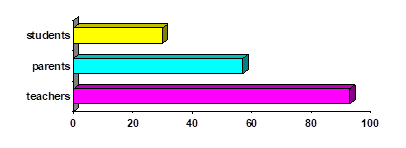
Fig. 1. A school uniform is thought to be necessary
About 96 % of teachers and 60 % of parents affirm it is necessary.
As for our students we have found the following:
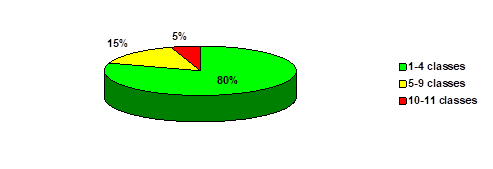
Fig. 2. School uniform is thought to be necessary. Students’ opinion
Our survey has shown that almost all junior schoolchildren comply wearing a school uniform as they like it.
Benefits of introducing a school uniform
The next research question was to find out the benefits of wearing a school uniform at our lyceum. Does a school uniform smooth over social contrasts at our school?
We have found out what our interviewees think about the benefits of introducing a school uniform at our school.
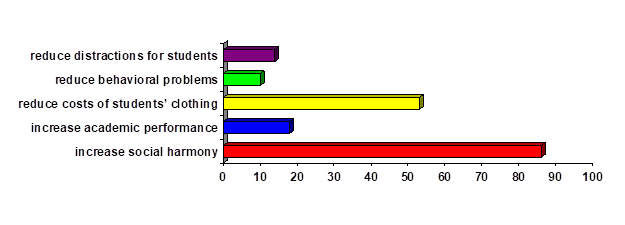
Fig. 4.Reasons for introducing a uniform

A large number of interviewees think that a school uniform increases social harmony at school. They are sure that school uniforms smooth over social contrasts. See figure 5.

Fig. 5. Social equalizer
In addition, attention has been given to school uniform’s effects on academic achievement and behavior.
Most teachers think that a school uniform improves academic achievements. See table 3.
Table 3
Academic achievements and school uniform (Do you think that a school uniform improves academic achievements?)
|
Yes |
No |
Don’t know |
|
|
educators |
64 % |
21 % |
15 % |
|
parents |
29 % |
49 % |
22 % |
|
students |
11 % |
80 % |
9 % |
Not only teachers but most parents think that school uniforms improve student behavior.
See table 4
Table 4
Student behavior and school uniform (Do you think school uniforms improve student behavior?)
|
Yes |
No |
Don’t know |
|
|
educators |
72 % |
18 % |
10 % |
|
parents |
57 % |
27 % |
16 % |
|
students |
13 % |
83 % |
4 % |
A handsome majority of students thinks that there is no correlation between a school uniform and academic achievement, between a school uniform and student behavior.
It should be noticed that using the information of the public reports of our school we can state there are no significant changes in the last 3 years educational work in comparison with non-uniformed years.
Students’ attitude towards a school uniform
Lastly, we have found out how often our students wear a school uniform. See the results in figure 5.
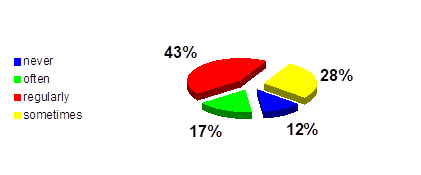
Fig. 5. How often it is worn at school
12 % of our students never wear it, 28 % put it on sometimes.
Parents’ attitude towards the cost of a school uniform
291 parents of our students have been asked the question on the cost of our school uniform. Before that we found out with what group they associate themselves: high-income household, low-income (including families having many children) or middle-income family. See the results in figure 6.
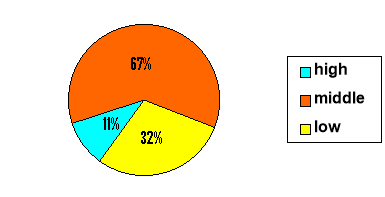
Fig. 6. Family income
What do the parents think about the cost of a school uniform? They have been offered to choose the following options (see table 5):
Table 5
Parents’ attitude towards the cost of a school uniform
|
no matter |
much for the family budget |
very expensive |
don’t know |
|
|
high-income |
23 |
0 |
0 |
9 |
|
middle-income |
26 |
97 |
18 |
24 |
|
low-income |
0 |
51 |
30 |
13 |
|
total |
49 |
148 |
48 |
46 |
228 (67 %) parents think the cost of a school uniform is too high for their family budget because it is bought at least every two years.
Conclusion and Recommendations
Conclusion
– Despite the fact that a school uniform is believed to be a social equalizer, a large number of students don’t like it. 12 % of our students never wear it, 28 % put it on sometimes.
– Judging by our survey and the school public report students’ clothing is not correlated with students’ behavior and achievements. Many students believe the school uniform policy is ineffective at controlling problem behavior.
– More than 70 % of parents claim they spend a lot of money on a school uniform, in particular, it is important for low income persons and large families.
– Having introduced a school uniform in 2015 the school administration carried out the law “On education” but failed in its objects such as decreasing truancies and behavioral problems, increasing academic performance.
Recommendations
Our research work and analysis of literature revealed extensive and detailed information on a school uniform’s impact on academic achievements, behavior, cost and implementation of school uniform policies. Specific recommendations should be given to our school administration with regard to 1) a school uniform and academic achievements; 2) a school uniform and student behavior; 3) a school uniform and its cost.
- Our study revealed no correlation between a school uniform and academic achievements. Due to this lack of correlation, poor students should not be required to wear a school uniform in order to improve their achievements. No one can say a student would be good at studying if he/she wore a school uniform. Wearing a school uniform should not be also used as a reason for adults when talking about school results. First of all, it is a question of teaching techniques and methods. A focus should be given to other options such as programs for additional teacher training or at-risk student intervention in order to improve student academic achievement.
- In spite of the fact that some researchers (Han, 2010) affirm uniforms have the most positive impact on elementary and middle school students our study showed no correlation between a school uniform and student behavior. Therefore, students who just don’t like to wear a school uniform should not be disciplined or, even worse, expelled from our lyceum. It goes without saying, students can not be suspended from school for no other reason than lack of money to buy a school uniform. Low-income families should be respected. That is why these provisions must not be included in the statute of our lyceum. Every child has the right to free education in a school. It is more important than the requirement of wearing a school uniform. Uniforms appear to be a viable option for elementary and a part of middle-school students.
- Care must be taken when implementing the uniform policy to ensure that teachers, parents and students perceive benefits to our lyceum. If not it may look like a burden for some families. Anyway, the cost must be suitable for a great number of parents. To improve students’ attitude towards a school uniform, it is recommended that students be consulted when designing and implementing a school uniform policy.
References:
- Alspach, Kyle, \Measured Look at Uniforms: Alternative to Dress Code», Retrieved from http://www.utdallas.edu/research/tsp-erc/pdf/seminar_paper_imberman.pdf
- Bodine, Ann, \School Uniforms, Academic Achievement, and Uses of Research», The Journalof Educational Research, 2003, 97 (2)», Retrieved from http://www.jstor.org/stable/27548012?seq=1#page_scan_tab_contents
- Brunsma, D. L., & Rockquemore, K. A. (1998). Effects of student uniforms on attendance, behavior problems, substance use, and academic achievement. The Journal of Educational Research, 92 (1). Retrieved from http://rockqu.tripod.com/uniform.htm
- Brunsma, David L., The School Uniform Movement and What it Tells Us About American Education, Scarecrow Education, 2004. Retrieved from http://digitalcommons.lmu.edu/cgi/viewcontent.cgi?article=1593&context=ce
- DaCosta, K. (2006). Dress code blues: An exploration of urban students' reactions to a public high school uniform policy. The Journal of Negro Education, Retrieved from http://research7900.wikispaces.com/file/view/uniform3.pdf
- Evans, David, Michael Kremer, and Muthoni Ngatia, \The Impact of Distributing School Uniforms on Children's Education in Kenya», Retrieved from http://www.csae.ox.ac.uk/conferences/2008-EdiA/papers/297-Ngatia.pdf
- Gentile, E., & Imberman, S. (2009). Dressed for success: Do school uniforms improve student behavior, attendance, and achievement? Retrieved from http://www.nber.org/papers/w17337.pdf
- Gouge, William Elihue, A comparison research study on the use of school uniforms and graduation, attendance, and suspension rates in east Tennessee, Retrieved from http://association-ko.ru/files/A %20COMPARISON %20RESEARCH %20STUDY %20ON %20THE %20USE %20OF %20SCHOOL %20UNIFORMS.pdf
- Han, S. (2010). A mandatory uniform policy in urban schools: Findings from the school survey on crime and safety: 2003–04. International Journal of Education Policy and Leadership, Retrieved from http://journals.sfu.ca/ijepl/index.php/ijepl/article/view/253/96
- Heckman, James J. and Yona Rubinstein, \The Importance of Non cognitive Skills: Lessonsfrom the GED Testing Program», Retrieved from http://www.econ-pol.unisi.it/bowles/Institutions %20of %20capitalism/heckman %20on %20ged.pdf
- Heckman, James J. Jora Stixrud, and Sergio Urzua, \The Effects of Cognitive and Noncognitive Abilities on Labor Market Outcomes and Social Behavior», Retrieved from http://athens.src.uchicago.edu/jenni/NIH_2006/cognoncog_all_2006–01–19_av.pdf
- Imberman, Scott A., \Achievement and Behavior of Charter Students: Drawing a More Complete Picture», Retrieved from http://www.uh.edu/econpapers/RePEc/hou/wpaper/2009–01.pdf
- Reed, Joshua B. Effects of a school uniform policy on an urban school district, retrieved from http://www.nmu.edu/sites/DrupalEducation/files/UserFiles/Files/Pre-Drupal/SiteSections/Students/GradPapers/Projects/Reed_Joshua_MP.pdf
- Yeung, Ryan, \Are Uniforms a Good Fit?: Results from the ECLS-K and the NELS», Educational Policy, 2009, retrieved from http://research7900.wikispaces.com/file/view/Educational+Policy-2009-Yeung-847–74.pdf
[1] The Programme for International Student Assessment (PISA) is a triennial international survey which aims to evaluate education systems worldwide by testing the skills and knowledge of 15-year-old students.
[2] Nine out of ten










